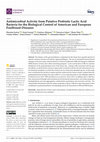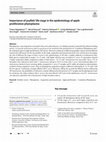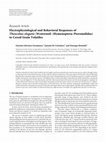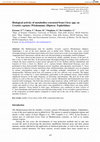Papers by Antonio De Cristofaro

Veterinary Sciences
The balance of the gut microbiome is important for the honey bee’s growth and development, immune... more The balance of the gut microbiome is important for the honey bee’s growth and development, immune function and defense against pathogens. The use of a beneficial bacteria-based strategy for the prevention and biocontrol of American foulbrood (AFB) and European foulbrood (EFB) diseases in honey bees offers interesting prospects. Lactic acid bacteria (LAB) are common inhabitants of the gastrointestinal tract of the honey bee. Among LABs associated with bee gut microbiota, Lactiplantibacillus plantarum (previously Lactobacillus plantarum) and Apilactobacillus kunkeei (formerly classified as Lactobacillus kunkeei) are two of the most abundant species. In this study, four Lactiplantibacillus plantarum strains and four Apilactobacillus kunkeei strains, isolated from the gastrointestinal tract of honey bee (Apis mellifera L.) were selected for their in vitro inhibition ability of Paenibacillus larvae ATCC 9545 and Melissococccus plutonius ATCC 35311. In addition, these LABs have been chara...

Food Chemistry, 2022
The quality of honey is assessed through the determination of some commodity parameters: a certai... more The quality of honey is assessed through the determination of some commodity parameters: a certain importance is to be attributed to the absence of contaminating residues, in particular of Polycyclic Aromatic Hydrocarbons (PAHs). This paper deeply investigates the presence of 22 PAHs in 57 honey samples collected in Central Italy and identifies the possible source apportionment and fingerprint identification by DLLME-GC-MS analysis and a chemometric approach. Cluster Analysis and Principal Component Analysis have allowed to identify the main PAHs responsible of the contamination, benzo[a]anthracene and phenanthrene, characteristics pollutants of areas constantly exposed. The entire database has been compared to similar ones present in literature, particularly data from Serbia and Belgrado samples. The PCA applied to overall the data confirms the combustion to be the main contamination source in Italian samples whereas highlights the importance of the role of naphthalene, added during beekeeping practices in the other data-set.
Insects, 2021
This article is an open access article distributed under the terms and conditions of the Creative... more This article is an open access article distributed under the terms and conditions of the Creative Commons Attribution (CC BY
Hoy en dia, la gestion de la polilla de la vid (GM), Lobesia botrana (Lepidoptera Tortricidae) en... more Hoy en dia, la gestion de la polilla de la vid (GM), Lobesia botrana (Lepidoptera Tortricidae) en los vinedos, se basa principalmente, en su control con insecticidas, a pesar de que las estrategias preventivas, como la tecnica de la confusion sexual, son cada vez mas utilizadas y de forma eficaz en los vinedos europeos (Ioriatti et al., 2008).

Journal of Pest Science, 2019
Phytoplasmas, microorganisms associated with severe plant diseases, are obligate parasites transm... more Phytoplasmas, microorganisms associated with severe plant diseases, are obligate parasites transmitted by phloem-feeding insects. Cacopsylla melanoneura and Cacopsylla picta are involved in the transmission of 'Candidatus Phytoplasma mali,' the etiological agent of apple proliferation (AP) disease. Research conducted in different geographic regions showed different transmission efficiencies for the two psyllids. In this study, acquisition and transmission trials were carried out to investigate the role of different life stages of these vectors in the epidemiology of AP after a sudden outbreak in northeastern Italy. Both species resulted able to acquire 'Ca. P. mali,' with higher infection rates recorded in C. picta. F1 generations showed a higher acquisition ability compared to adults in both species. 'Ca. P. mali' transmission was successful: Up to 1.5% of test plants were infected in trials with C. melanoneura and up to 10.2% in trials with C. picta. Overwintered adults of C. melanoneura showed a lower vectoring ability compared to C. picta. F1 nymphs and F1 adults, developed on infected plants, resulted in being competent vectors. Data on phytoplasma acquisition suggest a different relationship of 'Ca. P. mali' with the two species, evidencing a stronger affinity with C. picta. Moreover, taking into account the different factors influencing AP transmission, the probability of infection is mainly influenced by the presence of F1 nymphs and the phytoplasma load. In conclusion, this study evidences that C. picta is the most effective AP vector in the studied area, even if C. melanoneura can represent a potential risk in the presence of high inoculum sources.

Scientific Reports, 2019
Dittrichia viscosa (L.) Greuter, a perennial weed of the Mediterranean area, was reported to be s... more Dittrichia viscosa (L.) Greuter, a perennial weed of the Mediterranean area, was reported to be source of active substances. Here, by means of both ingestion and contact assays, the biological activity of three different extracts (n-hexane, methanol, and distilled water) of D. viscosa aerial part has been evaluated against Sitophilus granarius (L.) adults, an important pest of stored grains. Ingestion assays showed negligible mortality and food deterrence for all the extracts, whereas only a slight reduction of some nutritional parameters (relative growth rate, relative consumption rate, food efficiency conversion) was recorded for water extract. High contact toxicity was found only for the n-hexane extract (24 h median lethal dose LD50 = 53.20 μg/adult). This extract was further subfractioned by silica gel column chromatography and then by thin layer chromatography. Further contact toxicity bioassays highlighted two active subfractions which were analyzed by GC-MS. This revealed th...

BioMed research international, 2016
Volatiles emitted by the host's food would be the first signals used by parasitoids in the ho... more Volatiles emitted by the host's food would be the first signals used by parasitoids in the host location process and are thought to play an important role in host habitat location. In this study, the olfactory responses of Theocolax elegans (Westwood), a Pteromalid wasp that parasitizes immature stages of stored-product insect pests developing inside cereal or leguminous grains, to volatiles emitted by healthy wheat grains, their hexane extracts, and different doses of three individual compounds previously identified in cereal grain odors were investigated in Y-tube olfactometer and Petri dish arena behavioral bioassays and electroantennogram recordings. In Y-tube olfactometer bioassays, odors from healthy wheat grains and their hexane extracts were attractive to both sexes of T. elegans. Moreover, hexane extracts elicited arresting effects in Petri dish arena. The three synthetic compounds valeraldehyde, maltol, and vanillin elicited dose-dependent responses in both male and fe...

The Mediterranean fruit fly (medfly), Ceratitis capitata (Wiedemann) (Diptera: Tephritidae), is o... more The Mediterranean fruit fly (medfly), Ceratitis capitata (Wiedemann) (Diptera: Tephritidae), is one of the most injurious pest at global level. During the last years, several electrophysiological and behavioural studies have been carried out in order to investigate plant volatile compound-insect interactions with the aim to use this knowledge in sustainable control techniques. It has been observed that lemons are not attacked by medfly, probably because of the peel oil, that is toxic to other fruit flies. In the present paper electrophysiological recordings were conducted to evaluate the insect sensitivity to peel extract and peel oil of two Sicilian cultivars (Interdonato and Lunario) of Citrus x limon (L.) Burm.f. on C. capitata females. Behavioural bioassays were also performed to show their possible biological activity (repellent, antioviposition, insecticidal). C. limon peel extracts in different solvents (petroleum ether, dichloromethane and methanol) were investigated at various concentrations using a single cell recording technique (stimulation of tarsal taste chemosensilla). Different tarsal taste cell responses to the two cultivars were recorded. The higher sensitivity was evoked by C. limon Interdonato, particularly to the methanol extract, which elicited significant increases in the spike frequency at increasing concentrations. The peel oil of the same cultivars as well as that ones of other two C. limon varieties (Monachello and Femminello) have been tested by EAG techniques. The EAG data showed a high sensitivity (about-8.0/8.5mV) of the medfly antennae to the oils of Citrus spp. and a clear dose-response relationship. Responses of adult females (virgin and mated) to Citrus spp. peel extract were quantified in a double-choice test using yellow spheres (diameter 7.0cm) housed in field cages. Preliminary tests conducted on three extracts of C. limon Interdonato and Lunario have provided interesting results. It was recorded a general decrease of the oviposition on treated spheres compared to control and in the case of the cultivar Lunario, a mortality of insects.

Journal of Stored Products Research, 2000
Granary weevil Sitophilus granarius (L.) infestations in stored cereals are generally dicult to d... more Granary weevil Sitophilus granarius (L.) infestations in stored cereals are generally dicult to detect since the life cycle mainly takes place (from egg to pupa) inside the kernel. In order to detect the immature stages of S. granarius in wheat kernels a serological technique was set up. The antiserum was prepared by injecting rabbits with crude extract from larvae and pupae of S. granarius. Two dierent serological techniques (double diusion and immuno-osmophoresis) were compared using crude extracts coming from 10 g of wheat variably infested and ground by dierent procedures. The immunoosmophoresis displayed higher analytical resolution than the double diusion and it was able to detect the infestation due to a single larva (2nd, 3rd or 4th instar) or pupa in the crude extract. Moreover, this technique also provided information about the degree of infestation and the insect instar present in the kernel, based on the number of serologically positive samples (n 5 Â 10 g) and the position of the precipitin lines, respectively. The reproducibility of the results, the high analytical resolution, as well as its rapidity and technical simplicity, demonstrated the usefulness of the immuno-osmophoretic technique for the detection and quanti®cation of hidden insect infestations in stored wheat.

Journal of Stored Products Research, 2007
ABSTRACT The biological activity of propionic acid towards adults of the primary stored-grain pes... more ABSTRACT The biological activity of propionic acid towards adults of the primary stored-grain pests, Sitophilus granarius and S. oryzae was investigated by electroantennographic, behavioural and fumigant toxicity assays. Electroantennograms revealed the sensitivity of both sexes of the two species to propionic acid. In two-choice pitfall bioassays, the compound showed dose-dependent repellent effects even in the presence of wheat odours, which attracted the beetles. In the fumigation assay, propionic acid was effective in killing weevil adults. The LC50 values, calculated for both species at 23 and 30 degrees C, ranged from 5 to 10 mu g/L air and are comparable to those of other known fumigants. Propionic acid could have potential for applications in IPM programs for stored-grain beetles because of its safety, high volatility, repellency and fumigant activity. (C) 2006 Elsevier Ltd. All rights reserved.
Journal of Stored Products Research, 2009
Theocolax elegans (Westwood) is a pteromalid wasp that parasitizes immature stages of stored-grai... more Theocolax elegans (Westwood) is a pteromalid wasp that parasitizes immature stages of stored-grain insect pests. In a previous study, uninfested wheat kernels and their hexane extracts were shown to be attractive to the adult wasps. To contribute to the understanding of the olfactory basis of the host-habitat recognition, the electroantennographic (EAG) responses of both sexes of T. elegans to a

Journal of Chemical Ecology, 2008
The antennae of Sitophilus granarius (L.) (Coleoptera: Curculionidae) adults detect a wide variet... more The antennae of Sitophilus granarius (L.) (Coleoptera: Curculionidae) adults detect a wide variety of compounds in the odor blend of various cereal grains (Germinara et al., Tec. Molit., 53:27-34, 2002). In the present study, we looked at the behavioral responses of the granary weevil to 20 of these individual volatiles (aliphatic alcohols, aldehydes, ketones, and aromatics) in a two-choice pitfall olfactometer, using the aggregation pheromone and propionic acid as the attractant and repellent controls, respectively. Five doses, ranging from 1 microg to 1 mg, of each compound were tested. At least one concentration of eight compounds attracted beetles but required doses 1,000- to 5,000-fold higher than the concentration of aggregation pheromone to elicit a response. Three compounds, while attractive at lower concentrations, acted as repellents at higher doses. Twelve compounds were repellent at concentrations similar to the quantity of propionic acid that significantly repelled beetles. The data show that granary weevil adults have the ability to respond behaviorally to a wide range of cereal volatiles and that responses may change as a function of concentration. The results suggest that host finding behavior of weevils will depend on the balance of positive and negative volatile stimuli from grain as the relative concentrations of volatiles may change during storage. An understanding of how the weevils respond to such changes could be useful for the development of effective integrated pest management strategies.

Journal of Chemical Ecology, 2010
Dryocosmus kuriphilus is one of the most damaging pests of Castanea spp. Behavioral, chemical, an... more Dryocosmus kuriphilus is one of the most damaging pests of Castanea spp. Behavioral, chemical, and electrophysiological investigations were employed to examine the role of plant volatiles for host location by this thelytokuos cynipid. Y-tube olfactometer bioassays showed that adult wasps are significantly attracted by C. sativa twigs with at least 1-hr-old mechanical damage. Odors of undamaged host seedlings, intact twigs, and twigs with a fresh mechanical damage were not attractive. Wasps were repelled by plant materials of the non-host Prunus laurocerasus. Fourteen compounds, mainly general green leaf volatiles, were identified in the head-space of attractive host plant twigs by gas chromatography coupled to mass spectrometry. All compounds elicited dose-dependent antennal responses in adult wasps. A synthetic blend comprising all identified compounds in the same ratio as in the attractive host source induced significant positive responses in Y-tube olfactometer bioassays. The study gives a basis for future identification of host plant attractants that could contribute to semiochemical-based monitoring and management practices of this pest.









Uploads
Papers by Antonio De Cristofaro